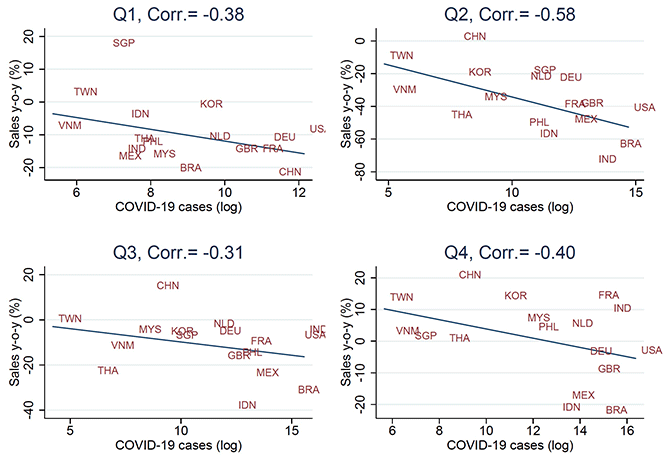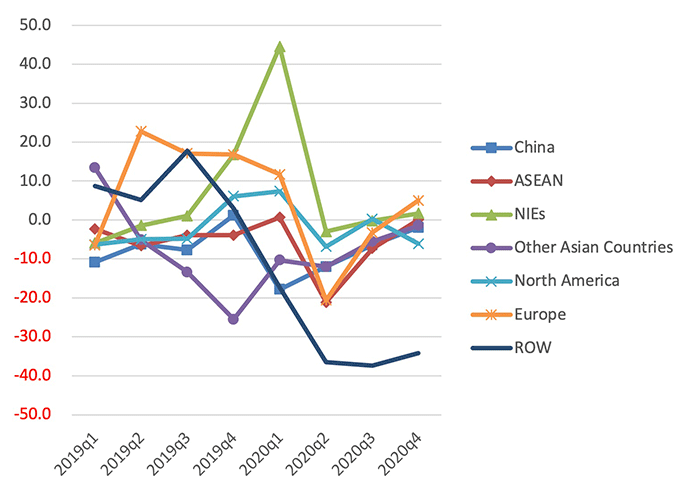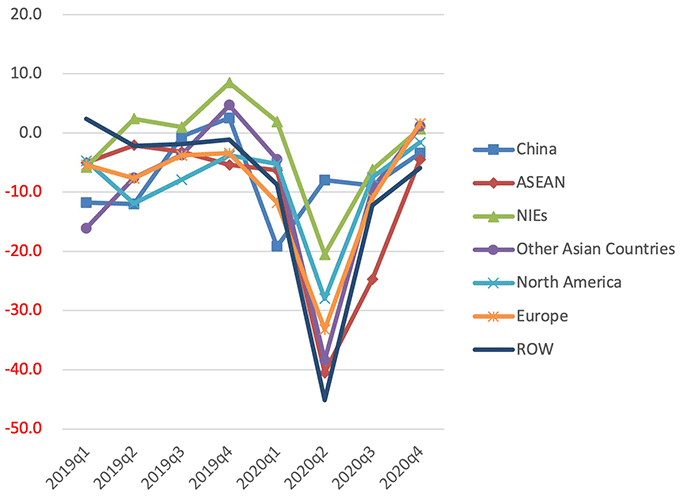COVID-19 has had large impacts on global production and international trade. The column uses quarterly aggregate-level data on foreign affiliates of Japanese multinational corporations to show that multinational production and supply chains were negatively affected by the COVID-19 pandemic, especially in the 2nd quarter of 2020. The sales of Japanese manufacturing affiliates almost recovered in the 4th quarter of 2020, indicating the resilience of global production and multinationals' supply chains. But there are large variations in recovery across countries.
The COVID-19 pandemic has had substantial impacts on the world economy. In 2020, world real GDP fell by 3.6%, the volume of world merchandise trade declined by 5.3%, and foreign direct investment (FDI) flows dropped by 42% (Note 1). Supply chains have been disrupted and both supply and demand shocks transmitted through supply chains and propagated across borders. As Baldwin and Tomiura (2020) point out, COVID-19 is as contagious economically as it is medically. To slow down the spread of the coronavirus, many countries imposed some form of restrictions on people and businesses. Previous studies have shown that the COIVD-19 had large negative impacts on global supply chains (Baldwin and Freeman 2020, Bonadio et al. 2020), international trade (Hayakawa and Mukunoki 2021), and the subjective uncertainty of global firms (Chen et al. 2021).
Since Japanese multinational corporations (MNCs) are important drivers and players in FDI and global value chains (GVCs), their overseas production and supply chains were hit hard by the COVID-19 pandemic. In a recent paper (Zhang 2021), I assess the impact of COVID-19 on global production by analysing quarterly data on the foreign manufacturing affiliates of Japanese MNCs.
Impact on sales of foreign affiliates of Japanese MNCs
In what follows, I document the impact of COVID-19 on the performance of Japanese manufacturing affiliates in major host countries. Figure 1 shows the relationship between the number of COVID-19 cases (in logarithms) and year-on-year (y-o-y) changes of total sales in 2020. The plots of y-o-y changes in sales against COVID-19 cases across countries show that sales decline significantly with increases in COVID-19 cases in each quarter. In other words, COVID-19 cases are significantly negatively associated with sales of Japanese affiliates in major countries, especially in the 2nd quarter of 2020. In Q1 2020, affiliates' sales in China (including Hong Kong) and Brazil sharply decreased by about 20% y-o-y, whilst sales in Taiwan and Singapore only increased. In Q2, whilst China had almost recovered from the COVID-19, the sales of Japanese affiliates dropped substantially in all other countries. India, Brazil, and Indonesia were the worst amongst them. Importantly, the fitted lines for Q1 and Q2 show that the negative correlations between COVID-19 cases and sales growth rates became significantly stronger from Q1 2020 to Q2 2020. This suggests that the pandemic and the performance of Japanese affiliates were getting worse in major countries, except China. In Q3, affiliates' sales in China continued to increase. The situation in other countries was improving relative to Q2, but most of them still had large decreases in sales. In Q4, the sales of Japanese affiliates in most countries recovered but there are still large variations across countries, implying the differences in recovery from the pandemic.

Supply chains disruption and recovery
COVID-19 disrupted supply chains regionally and globally. Figure 2 shows the y-o-y changes of overseas affiliates' exports to Japan by region from Q1 2019 to Q4 2020. In Q1 2020, due to the rapid spread of COVID-19 in China, Japanese affiliates' exports from China to Japan had a substantial decrease of 17.8% y-o-y. COVID-19 shocks hit China–Japan trade hard as the supply chains of Japanese firms rely heavily on China. In contrast, in ASEAN, newly industrialised economies (NIEs), North America, and Europe, exports to Japan increased by 0.7%, 44.5%, 7.4%, and 11.7% y-o-y, respectively. The sudden increase in NIEs, especially the Republic of Korea and Taiwan, may reflect the substitution effect as imports from China were disrupted in Q1. However, in Q2 2020, although Japanese affiliates' local sales in China almost recovered and increased by 6.7% y-o-y, their exports to Japan continued to see a y-o-y decrease of 12%. The situation in non-China regions such as ASEAN and Europe was even worse (about –20% y-o-y). ASEAN, which is expected to be an important alternative sourcing origin, also experienced significant decreases. The supply chains between ASEAN and Japan were in crisis as well. In Q4 2020, exports to Japan were recovering in all regions except the rest of the world (ROW).

Source: Author's own compilation based on the QSOS, METI.
Similarly, Figure 3 shows that Japanese manufacturing affiliates' exports to third countries fell sharply during Q1–Q2 2020. Importantly, the impact was much larger relative to exports to Japan. On average, the y-o-y changes of exports to third countries were –9.5% and –33.4% in Q1 and Q2, whilst the y-o-y changes of exports to Japan were –5.5% and –16.5% during the same period. Foreign affiliates' exports to third countries were recovering in Q3 2020 but did not return to pre-COVID-19 levels. It is also worth noting that ASEAN-based affiliates had the lowest recovery in Q3. Whilst their exports to Japan were –7.2% y-o-y in Q3, their exports to third countries were much lower, at –24.7% y-o-y. This suggests that the negative demand shock was much larger in the third countries, relative to Japan. In Q4 2020, exports to third countries almost recovered in all regions.

Source: Author's own compilation based on the QSOS, METI.
Policy implications
The ongoing COVID-19 pandemic will likely transform global production. UNCTAD (2020) argues that reshoring, diversification, and regionalisation will drive the restructuring of GVCs in the coming years. This column provides some policy implications for global production and the re-evaluation of supply chain strategy in the post-COVID era. To reduce the reliance on supply chains in China, in April 2020, the Japanese government approved a fiscal stimulus package including ¥220 billion (US$2 billion) for manufacturing firms to move production home and ¥23.5 billion ($0.2 billion) to move production to ASEAN countries. However, China has brought the spread of COVID-19 under control, and the supply chains and economic activities have recovered since Q2 2020. On the other hand, Japan, ASEAN, and the ROW were hit hard by the pandemic at the same time. As shown in Bonadio et al. (2020), the renationalisation of global supply chains does not make countries more resilient to pandemic-induced contractions in the labour supply. Therefore, it is geographical diversification in sourcing and sales, not the reallocation of production and supply chains, that makes firms and the economy more resilient to supply chain disruptions and disasters. Resilience in global supply chains can be increased through building buffer stocks and making standardised inputs easier to replace, identifying places and suppliers that are less subjective to risk, and assessing the time to recovery for each type of supplier (Miroudot 2020). Policies in the future should support business efforts to build more robust and resilient supply chains.
Editor's note: The main research on which this column is based first appeared as a Discussion Paper of the Research Institute of Economy, Trade and Industry (RIETI) of Japan.
This article first appeared on www.VoxEU.org on September 13, 2021. Reproduced with permission.


